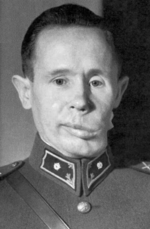Bruno Sutkus (lith.
Bronius Sutkus, 14 May 1924 – 29 August 2003) was a
Germansniper in the
68th Infantry Division on the
Eastern Front of World War II, and was credited with 209 kills.Every kill was recorded in an individual "sniper's book" and had to be confirmed by at least one observer and authenticated by the battalion commander. Facsimile copies of various diary pages are reproduced in Sutkus' memoir. other soldiers and superior authority. After the dissolution of the Soviet Union, Sutkus held lectures for Lithuanian soldiers and presented his wartime records to Lithuanian officers.
Sutkus was born in Tannenwalde (suburb of
Königsberg in
East Prussia). His father was Lithuanian, which meant that Sutkus was not automatically German, German nationality had to be applied for. Since no application was made he remained officially Stateless until 1941 when he became a naturalized German. He joined the
Hitler Youthin 1938, achieving the rank of a Scharführer. When he was 18 years old he became a member of the
SA, where his shooting skills were acknowledged, and he was given a rifle to take home and practise marksmanship.
Sutkus trained as a sniper from August 1943 through the end of December 1943 at the Sniper School
Vilnius, before being assigned to the
68th Infantry Division. In January 1945 while recovering from a wound he was promoted and informed that he had been appointed as an instructor at a sniper school.
In his autobiography, Sutkus describes that after the war he came into contact with the
Lithuanian resistance (cf.
Forest Brothers), how he was captured and severely tortured by the
KGB. He was in possession of forged documents declaring him to be Stateless and of having worked throughout the war as a farm labourer, but knew the Russians suspected him of having served in the Wehrmacht as a sniper. Accordingly he volunteered for banishment to
Siberia for forced labor in order to escape their attentions. By the time the Russians had the evidence to try him for the "war crime" of being a sniper, West German Chancellor
Konrad Adenauer had negotiated amnesties for many Germans being detained in the Soviet Union. He worked on collectives, in the Taiga forests and down the pits at Sheernkov from 1949 until 1971 when he was allowed to relocate to
Vilnius. Sutkus went into voluntary banishment to accompany a Lithuanian woman, Antoniena, (d.1995) nineteen years his senior, who had been linked to the Resistance. He had a son, Vytautas, by her in 1951. In 1991 after the collapse of the Soviet Union, Sutkus, now Lithuanian after having been forced to accept Soviet citizenship, visited Germany. In 1994 he received a certificate of German citizenship and passport, and relocated to Germany in 1997.
MEMORABLE QUOTATION
Sutkus quoted two members of the Lithuanian resistance who tried to persuade him not to join their ranks (Diary of a sniper, page 75):
- "If you can live legally you'll grow 80 years old. Joining the guerrilla you will die. They will torture your parents and send them to Siberia. We can't achieve anything because the Soviet predominance is crushing. We're constantly haunted. We have no area for retreat, no supplies and no food. Large Soviet forces are searching the woods. Often we are starving and the wounded get no treatment. The people who support us get arrested, viciously tortured and send to Siberia. Sooner or later the Soviets will choke the whole Lithuanian resistance in blood. We're all going to die. They will throw our desecrated bodies onto the marketplace. Reconnaissance planes are often flying over the woods to take pictures. Spies are infiltrating our ranks. Day and night we can't feel safe in the bunkers and are therefore always moving, to again and again, like rats, dig new bunkers into the soil. There's no other way.
- One of us shall survive to be able to tell how we lived, fought, and died."
AWARDS










